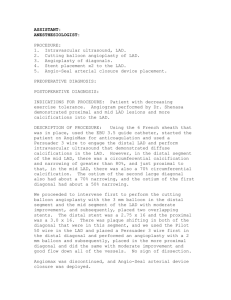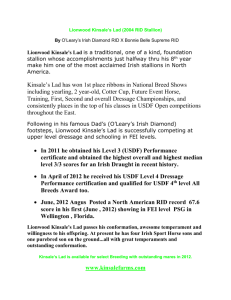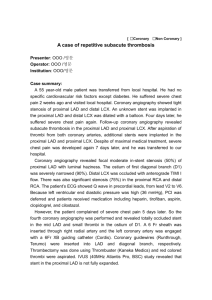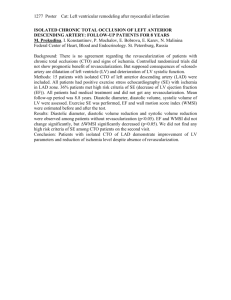Report
advertisement
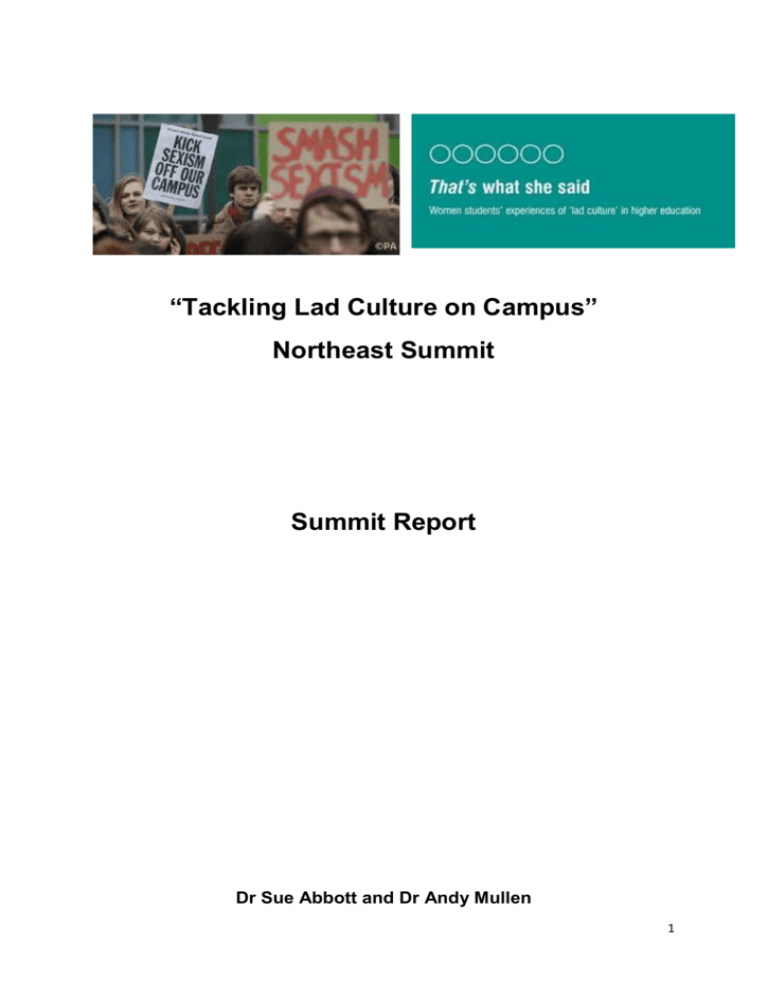
“Tackling Lad Culture on Campus” Northeast Summit Summit Report Dr Sue Abbott and Dr Andy Mullen 1 What is ‘Lad Culture’? While some people may dismiss lad culture (i.e. sexist and homophobic language and behaviour rooted in a warped sense of masculinity) as ‘harmless’ and ‘just a bit of fun’, the research to date indicates that it leads to a whole set of problems on campus and in wider society. These include Verbal abuse and humiliation Harassment Sexualisation and objectification Rape-supportive attitudes Sexual assault and rape Homophobia and transphobia Encouragement of a ‘pack mentality’ and ‘pack behaviour’ Binge drinking Low self-esteem Feeling unsafe Anxiety Depression and suicidal feelings High drop-out rates Importantly, this is not just an issue for women; men also suffer in a lad culture that is oppressive and which defines masculinity in such narrow terms. The National Union of Students (NUS) published its latest research report on lad culture, entitled That’s What She Said, in February 2014. It subsequently devised a national strategy on lad culture, established a committee and a dedicated team to oversee and deliver the strategy, and called upon ministers to organize a national summit to tackle the problem. In September 2014, the NUS conducted a survey to quantify the problem and it found that one-in-four students had suffered from unwelcome sexual advances (e.g. inappropriate groping and touching): 37 per cent women and 12 per cent of men. That same month, the NUS launched a pilot project – focusing upon ten higher education institutions across the country – in order to assess what lad culture looked like on their campuses and to investigate if and how it was being tackled. Lad Culture Project Having been awarded a HEIF Research Impact Fund grant in November 2014, a steering group was established to ensure that the Lad Culture project achieved its aims and objectives plus the four agreed outputs: 2 Objective 1 (local involvement and research into local strategies) Contact was made with the students’ union equality and/or women’s officers at Durham, Newcastle, Northumbria and Sunderland and representatives were invited to join the steering group. Meetings were held on the 17 December, 14 January, 10 February and 12 March, minutes were taken and the notes of the discussions were circulated to the steering group. Members outlined how their institutions were attempting to tackle lad culture. Members were also involved in planning the Summit and they actively participated on the day. Objective 2 (‘best practice’ interviews and evaluation report) Although no formal interviews were conducted, examples of local and national attempts to tackle lad culture on campus were captured – in both the minutes of the steering group meetings and in the presentations at the Summit which were recorded. The latter will be made public so that those who could not attend the event can watch the proceedings, and can find out about local and national good practice in terms of tackling the problem of lad culture on campus. The Summit itself received some media coverage – in both local newspapers and radio and in the Times Higher Education. This document serves as an evaluation report. Following the Summit, Dr Abbott and Dr Mullen convened a gathering of Northumbria academics who are interested in pursuing the tackling lad culture on campus agenda. Meeting on 19 May, these staff agreed to form a working group to build upon the success of the Summit and pursue some of the recommendations in this report (see below). Dr Abbott and Dr Mullen have also been invited to attend a one-day seminar on lad culture at Leeds University on 5 June with the author of the 2013 NUS report, That What She Said, to consider how this area of research might develop further. Objective 3 (sharing the findings) Videos of the Summit presentations will be made publicly available and copies of this report will be disseminated to the NUS and other interested parties in the broader national research community. Objective 4 (GILD) The data produced by this project will be reviewed by the Faculty Gender Identity and Leadership research interest group when it next meets. 3 The Summit On Wednesday 15 April 2015, Northumbria University hosted the first Northeast Summit on “Tackling Lad Culture on Campus”. Attended by approximately 80 staff and students from higher education institutions across the Northeast, this event sought to raise awareness of lad culture, to identify how prevalent this is in Northeast universities locally and to explore how it might best be tackled by staff and students. There was a plenary session featuring several national and local speakers: Dave Llewellyn from the Good Lad Initiative presented an overview of the multidisciplinary approach that is used by the Good Lad Initiative team in their workshops. These workshops aim to encourage men to reflect upon their attitudes and behaviour towards women, particularly when in groups, and to shift from ‘bad lad’ to ‘good lad’ attitudes and behaviour. Several workshops have been held across the country, which were well-received, and the project has received some national press attention (see http://www.theguardian.com/education/2014/nov/12/lad-cultureworkshops-unversity-campuses-sexual-harassment). A video of Dave Llewellyn’s presentation can be viewed here: ………………….. Vanita Sundaram from York University presented some new research findings. Where previous work had focused almost exclusively on the experiences of female students at universities, Vanita explored how the issue of lad culture is viewed by academic staff. Disturbingly, Vanita found that many academics were relatively ignorant of the problem, tended to downplay and dismiss the issue, and/or even considered it a positive phenomenon – as evidence of male bonding and peer acceptance. A video of Vanita Sundaram’s presentation can be viewed here: ……………………….. Minda Burgas-Lukes from the NUS presented an overview of the national work undertaken by the NUS thus far. This included several research reports, the formation of a steering committee (which Sue Abbott, Dave Llewellyn and Vanita Sundaram are members of) and a pilot project which investigated what individual higher education institutions were doing to tackle this issue. 4 A video of Minda Burgas-Lukes’s presentation can be viewed here: ……………………. Local representatives from the students’ unions at Durham, Newcastle, Northumbria and Sunderland universities then provided a brief overview of what efforts had been made at their institutions to tackle lad culture. The workshops After the plenary session, two workshops were held – one for staff and the other for students – which focused upon how lad culture could be practically tackled on campus. Staff and students came up with the following ideas about how to bring about the desired cultural changes and these have been categorised into themes: University management actions Ensure that existing policies (e.g. equality and diversity policy, safe space policy, no platform policy, etc.) are promoted and adhered to. Ensure that staff are provided with training about lad culture and how to tackle it (the ‘unconscious bias’ training was cited as a particularly useful approach). Universities need to ensure that monitoring systems and support networks for staff and students are in place. Promote the Safe Studies Network (which focuses upon research and campaigning on campus cultures, gender and violence) in each of the Northeast institutions - see https://safestudiesnetwork.wordpress.com/). Discourage the use of websites that encourage the rating of staff by students (often the appearance of female lecturers). Ensure that university accommodation (both halls of residence and recommended landlords) is safe and appropriate. Focus on each of the Northeast institutions’ marketing policies to ensure that universities’ projected images are not contributing to the problem of lad culture. Attention needs to be paid to collecting data about the incidences of sexist abuse, harassment and violence of campus. Universities and students’ unions both have a role in this. A telephone helpline may be a useful resource. 5 Staff actions Attention should be paid to the curriculum and how to embed the tackling of lad culture in our lectures and seminars. We can draw upon the work of Sue Abbott and others in Northumbria Business School, and the work of staff in Geography, etc. Attention should be paid to ensuring that lectures and seminars are safe spaces for – by raising awareness of the issues, setting groundrules, etc. This is particularly important for first years and should be an integral part of new students’ induction. Likewise, for staff. We can draw on the work done by Geography and the ‘Equality and Diversity in Action’ document that was produced by Northumbria University and College Union. Set up a staff and student network within each institution, and perhaps across the region, to tackle lad culture. Promote the use of the ‘Intervention Initiative’ (a toolkit for the prevention of domestic abuse and sexual coercion on campus – see http://www1.uwe.ac.uk/bl/research/interventioninitiative.aspx). Public Health England will be writing to all university vice-chancellors to ask how they intend to tackle lad culture. Activists in each of the Northeast institutions should follow this up. Zero-tolerance campaigns should be launched in each of the Northeast institutions using traditional and social media to get the messages across the staff and students. Elicit the support of senior management in each of the Northeast institutions. They have a duty of care towards their staff and students. Furthermore, with their political support, the deployment of their marketing/publicity machines will ensure that the key messages of any no tolerance campaign are amplified. Student actions Encourage the NUS to develop a ‘model’ or template policy that can be adapted and adopted by institutions across the country. Work with and through student societies such as the Feminist Society. Focus on each of the Northeast institutions’ marketing policies to ensure that universities’ projected images are not contributing to the problem of lad culture. Likewise, the marketing policies and activities (e.g. Induction Week, Rag Week, sports events, etc.) organized by students’ unions. Student unions’ welfare teams should be asked to produce regular reports on what they are doing to tackle lad culture. Classes and/or workshops should be organised for those students that want to raise awareness of lad culture in schools and colleges. The issue needs to 6 be tackled before students get to university. Northumbria Students’ Union are taking up this idea. Promote the “It Happens Here” campaign (i.e. tackling sexual violence) developed by Oxford and Newcastle universities (see http://www.nusu.co.uk/news/article/6516/It-Happens-Here/) and share good practice in terms of actual solutions. To generate awareness of, and interest in, the tackling of lad culture it might be useful to set up a specific Northumbria University Facebook page. Encouraging reporting and developing support networks In cases of sexual abuse, harassment and violence, women should be encouraged to contact and report to the police. That is why we pay our taxes! Draw upon the resources and support of local authorities, local crime commissioners, the police (community safety), trade unions, etc. in terms of resources (e.g. campaigning and publicity materials) and support services. General The term ‘lad culture’ is not a particularly useful one as it encompasses a multiplicity of issues and problems; it should, therefore, be unpacked and each issue and problem dealt with more specifically. Challenge the individualism and neo-liberalism that encourages and underpins lad culture. This entails rejecting the notion of ‘students as customers’ and that they are entitled to behave as they please. While universities cannot control their external environments, thus limiting their actions, this does not mean that universities cannot ensure that they are safe spaces. Moreover, in ensuring that they are space spaces, they will raise awareness and expectations and thus have an impact on the wider social culture. Additional ideas from the evaluation forms More awareness-raising on campus. Collaboration between student unions and other trade unions (e.g. UCU, Unison, etc.) on campus. Careful vetting of commercial groups and organizations before they are allowed on campus (for Freshers’ Week events, etc.). Encourage sports teams to sign up for the Good Lad Initiative workshops. 7 In terms of work with schools and colleges, attention should focus upon the effects of alcohol and drug use on behaviour and consent, healthy relationships, etc. The NUS should produce a newsletter to raise awareness and share good practice. Men and women need to be actively encouraged to engage in campaigns to tackle lad culture (so that men don’t feel targeted and so that women don’t let men ‘get away with it’ anymore). Results of the evaluation of the Summit A total of 28 evaluation forms were completed. Asked whether the Summit had been interesting in terms of the speakers and the issues discussed, all 28 affirmed that it had been an interesting event. Likewise, when asked whether the Summit had been useful in terms of information gleaned, ideas shared and contacts made, all 28 confirmed that it had been useful. Furthermore, 27 out of 28 found the venue for the Summit (Northumbria Business School) acceptable. Contact details Dr Sue Abbott, Northumbria Business School, City Campus East, Northumbria University, Newcastle upon Tyne, NE1 8ST – sue.abbott@northumbria.ac.uk Dr Andy Mullen, Department of Social Sciences, Lipman Building, Northumbria University, Newcastle upon Tyne, NE1 8ST – andrew.mullen@northumbria.ac.uk June 2015 8
